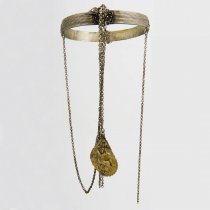A significant Palaeologan work
Icon of Saint George.
14th century.
BXM 1355
The icon, associated with a significant Constantinopolitan workshop, constitutes a valuable refugee heirloom, originating most likely in Tyana, Cappadocia. Its provenance has been documented in the BCM refugee heirlooms inventory. This information was possibly extracted from a rough note of the Tyana Board of Commissioners found in the Museum’s historical archive, in which the icon has been recorded. The icon was received “in two fragments”, on February 16 1925, together with 29 other objects,includinga post-byzantine icon of Saint Eustathios, also originating in Tyana, Cappadocia.
The icon of Saint George and the mosaic icon of the Virgin Glykophilousa “the Episkepsis” (BXM 990) are among the most important acquisitions of the Museum’s refugee heirlooms, offering valuable information on the high-level artistic creation that flourished in Constantinople during the Palaeologan period.
DOWNLOADS
Handwritten catalogue of refugee heirlooms from Cappadocia expected to be delivered to the Byzantine and Christian Museum. The paper bears the logo “Εφορεπιτροπεία Τυάνων” (Board of Commissioners of Tyana), yet it is not certain that all registered objects originated in Tyana. The icon of Saint George has been given the accession number 4.(pdf / 1,4 MB)
Typed proof of receipt of Asia Minor heirlooms, among which the icon of Saint George was assigned the accession number 12.(pdf / 5,4 MB)



.jpg)
.jpg)
.jpg)
 Purple Gospel
Purple Gospel .jpg) The double-sided icon from Tuzla
The double-sided icon from Tuzla .jpg) An emblematic refugee “relic”
An emblematic refugee “relic”  A byzantine Hodegetria
A byzantine Hodegetria  An Evangelistary from Trebizond
An Evangelistary from Trebizond .jpg) A significant Palaeologan work
A significant Palaeologan work  Tetraevangelion from Adrianople
Tetraevangelion from Adrianople .jpg) A Cretan icon from Eastern Thrace
A Cretan icon from Eastern Thrace .jpg) “Joined in matrimony”
“Joined in matrimony”  A peculiar neckband
A peculiar neckband  Fragmented memory
Fragmented memory .jpg) Zumzud, the pilgrim
Zumzud, the pilgrim .jpg) A refugee heirloom in “Russian style”
A refugee heirloom in “Russian style” .jpg) An unusual “icon” from Cappadocia
An unusual “icon” from Cappadocia .jpg) "He (the Lord) keeps all their bones …" (Psalm 33: 21)
"He (the Lord) keeps all their bones …" (Psalm 33: 21) .jpg) A Karamanli icon
A Karamanli icon 



